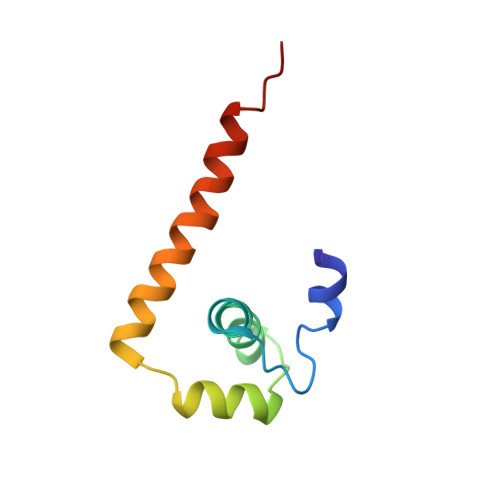Tick-borne encephalitis virus capsid protein induces translational shutoff as revealed by its structural-biological analysis.
Selinger, M., Novotny, R., Sys, J., Roby, J.A., Tykalova, H., Ranjani, G.S., Vancova, M., Jaklova, K., Kaufman, F., Bloom, M.E., Zdrahal, Z., Grubhoffer, L., Forwood, J.K., Hrabal, R., Rumlova, M., Sterba, J.(2022) J Biological Chem 298: 102585-102585
- PubMed: 36223838
- DOI: https://doi.org/10.1016/j.jbc.2022.102585
- Primary Citation of Related Structures:
7YWQ - PubMed Abstract:
Tick-borne encephalitis virus (TBEV) is the most medically relevant tick-transmitted Flavivirus in Eurasia, targeting the host central nervous system and frequently causing severe encephalitis. The primary function of its capsid protein (TBEVC) is to recruit the viral RNA and form a nucleocapsid. Additional functionality of Flavivirus capsid proteins has been documented, but further investigation is needed for TBEVC. Here, we show the first capsid protein 3D structure of a member of the tick-borne flaviviruses group. The structure of monomeric Δ16-TBEVC was determined using high-resolution multidimensional NMR spectroscopy. Based on natural in vitro TBEVC homodimerization, the dimeric interfaces were identified by hydrogen deuterium exchange mass spectrometry (MS). Although the assembly of flaviviruses occurs in endoplasmic reticulum-derived vesicles, we observed that TBEVC protein also accumulated in the nuclei and nucleoli of infected cells. In addition, the predicted bipartite nuclear localization sequence in the TBEVC C-terminal part was confirmed experimentally, and we described the interface between TBEVC bipartite nuclear localization sequence and import adapter protein importin-alpha using X-ray crystallography. Furthermore, our coimmunoprecipitation coupled with MS identification revealed 214 interaction partners of TBEVC, including viral envelope and nonstructural NS5 proteins and a wide variety of host proteins involved mainly in rRNA processing and translation initiation. Metabolic labeling experiments further confirmed that TBEVC and other flaviviral capsid proteins are able to induce translational shutoff and decrease of 18S rRNA. These findings may substantially help to design a targeted therapy against TBEV.
- Faculty of Science, the University of South Bohemia in České Budějovice, České Budějovice, Czech Republic; Institute of Parasitology, Biology Centre of the Czech Academy of Sciences, České Budějovice, Czech Republic. Electronic address: selinm01@prf.jcu.cz.
Organizational Affiliation:
















